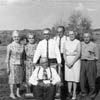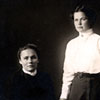Tipman Family
 The Tipman family's journey to western Canada began with a migration eastward to Tver in west central Russia. Along with hundreds of other families, the Tipmans founded homesteads. Due to political instability and unfavourable conditions, the Tipmans, like many other families, became dissatisfied with the status quo. Advertisements published by the Canadian Pacific Railway company highlighted the benefits of homesteading in western Canada. A 160-acre piece of land could be purchased for $10. An opportunity such as this appealed to the Tipmans, and they soon set sail across the Atlantic Ocean. Following a two-week journey by sea in 1903, the Tipmans were transported by train to Red Deer.
The Tipman family's journey to western Canada began with a migration eastward to Tver in west central Russia. Along with hundreds of other families, the Tipmans founded homesteads. Due to political instability and unfavourable conditions, the Tipmans, like many other families, became dissatisfied with the status quo. Advertisements published by the Canadian Pacific Railway company highlighted the benefits of homesteading in western Canada. A 160-acre piece of land could be purchased for $10. An opportunity such as this appealed to the Tipmans, and they soon set sail across the Atlantic Ocean. Following a two-week journey by sea in 1903, the Tipmans were transported by train to Red Deer.
When Magnus Tipman and his family arrived, he soon discovered that there was no longer any suitable space in the Medicine Valley on which to farm. The Tipmans ventured to Medicine Hat in search of suitable homesteads but, instead, they found the terrain too arid for farming. In 1904, the Tipmans discovered unsettled land near Stettler. Magnus built a large but modest one-room house with dirt flooring. Soon after, Magnus' brothers Juhan and Joseph and his sister Leena arrived, exhausted yet excited at the new opportunity.
Each of the Tipmans started his own homestead within a few miles of the others. This allowed family members to maintain a congenial social network. Joseph Tipman was actively involved in the community, serving on various agricultural and labour associations (e.g., Director of Stettler Co-operative Association).
Joseph had a short stint working in the coal mines of British Columbia until he was forced to return to Stettler due to a severe knee injury. In 1928, he bought a section of land and, like his brother Magnus had done years before, he began farming.
In the spring, Magnus, with the aid of oxen, cultivated five acres of land and seeded it with a mixture of barley, oats, and rye. A small plot was used as a vegetable garden. Like many other pioneer families, the Tipmans had to travel days by sleigh or wagon to purchase groceries in the closest town.

 In 1912, Magnus died in a tragic threshing accident. Eight years later, his wife, Sophia, passed away after a lengthy illness. They had five sons and three daughters: Johan (John), Mike, Ado, Ferdie, Edward, Mary, Sophie, and Louise. The farm remains in the Tipman family. However, a lifestyle based solely on agriculture was not feasible for the entire Tipman family. Several of the Tipman children became successful school teachers. In 1940, Ado Tipman married Aletha Klaus and he settled into a dual career of teaching and farming. They had three children: Bob, Allan, and Marlene. Bob served as the first president of the Alberta Estonian Heritage Society.
In 1912, Magnus died in a tragic threshing accident. Eight years later, his wife, Sophia, passed away after a lengthy illness. They had five sons and three daughters: Johan (John), Mike, Ado, Ferdie, Edward, Mary, Sophie, and Louise. The farm remains in the Tipman family. However, a lifestyle based solely on agriculture was not feasible for the entire Tipman family. Several of the Tipman children became successful school teachers. In 1940, Ado Tipman married Aletha Klaus and he settled into a dual career of teaching and farming. They had three children: Bob, Allan, and Marlene. Bob served as the first president of the Alberta Estonian Heritage Society.








